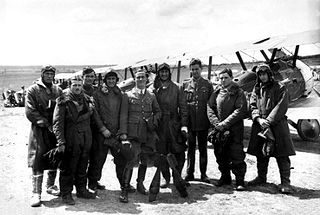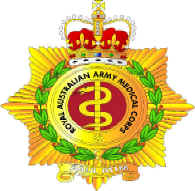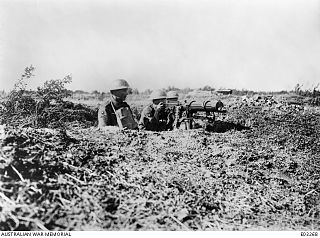Related Research Articles
Corps is a term used for several different kinds of organization. A military innovation by Napoleon, the formation was first named as such in 1805. The size of a corps varies greatly, but from two to five divisions and anywhere from 40,000 to 80,000 are the numbers stated by the US Department of Defense.

The First Australian Imperial Force was the main expeditionary force of the Australian Army during World War I. It was formed as the Australian Imperial Force on 15 August 1914, following Britain's declaration of war on Germany, initially with a strength of one infantry division and one light horse brigade. The infantry division subsequently fought at Gallipoli between April and December 1915, being reinforced by a second division which was later raised, as well as three light horse brigades. After being evacuated to Egypt the AIF was expanded to five infantry divisions, which were committed to the fighting in France and Belgium along the Western Front in March 1916. A sixth infantry division was partially raised in 1917 in the United Kingdom, but was broken up and used as reinforcements following heavy casualties on the Western Front. Meanwhile, two mounted divisions remained in the Middle East to fight against Turkish forces in the Sinai and Palestine.

The Royal Australian Armoured Corps (RAAC) is a corps of the Australian Army which provides the Australian Defence Force's armour capability. Armour combines firepower, mobility, protection and networked situational awareness to generate shock action and overmatch in close combat. Armour is an essential element of the combined arms approach that is employed by the Australian Army.

The Australian Flying Corps (AFC) was the branch of the Australian Army responsible for operating aircraft during World War I, and the forerunner of the Royal Australian Air Force (RAAF). The AFC was established in 1912, though it was not until 1914 that it began flight training.

The Royal Army Service Corps (RASC) was a corps of the British Army responsible for land, coastal and lake transport, air despatch, barracks administration, the Army Fire Service, staffing headquarters' units, supply of food, water, fuel and domestic materials such as clothing, furniture and stationery and the supply of technical and military equipment. In 1965 its functions were divided between other Corps and the RASC ceased to exist; subsequently, in 1993, they in their turn became the "Forming Corps" of the Royal Logistic Corps.

The Royal Australian Army Medical Corps (RAAMC) is the branch of the Australian Army responsible for providing medical care to Army personnel. The AAMC was formed in 1902 through the amalgamation of medical units of the various Australian colonies and was first deployed to South Africa as a small detachment of personnel supporting the Australian Commonwealth Horse during the Second Boer War. The corps has participated in every Australian Army operation since then, including wars and peacekeeping operations. The "Royal" prefix was granted in 1948.
The Royal Australian Air Force (RAAF) traces its history back to the Imperial Conference held in London in 1911, where it was decided aviation should be developed within the Armed Forces of the British Empire. Australia implemented this decision, the only country to do so, by approving the establishment of the Central Flying School (CFS) in 1912. The location for the proposed school was initially to be at Duntroon, Australian Capital Territory, but in July 1913 Point Cook, Victoria, was announced as the preferred location. The first flights by CFS aircraft took place there in March 1914.

No. 38 Squadron was a Royal Australian Air Force (RAAF) transport and training unit active between 1943 and 2018. It was formed on 15 September 1943 and saw service during World War II transporting supplies and personnel between Australia and the combat zones in New Guinea and Borneo, using Douglas Dakota aircraft. Following the war, the squadron conducted regular courier flights between Australia and Japan in 1947 and 1948. No. 38 Squadron was deployed to Singapore from 1950 to 1952, supplying Commonwealth forces engaged in the Malayan Emergency and undertaking courier flights across Asia. In 1954 it became responsible for training RAAF personnel to operate Dakotas.

ANZUK was a tripartite force formed by Australia, New Zealand and the United Kingdom to defend the Asian Pacific region after the United Kingdom withdrew forces from the east of Suez in the early 1970s. The ANZUK force was formed in Singapore on 1 November 1971 under Rear Admiral David Wells and disbanded on 31 January 1974.

The Royal Australian Engineers (RAE) is the military engineering corps of the Australian Army. The RAE is ranked fourth in seniority of the corps of the Australian Army, behind the Staff Cadets, Armoured and Artillery Corps. The corps was formed by the amalgamation of the various colonial engineer corps of the states and territories of Australia in 1902 and since then has served in various conflicts including World War I, World War II and the Vietnam War. The corps has also served on numerous peacekeeping operations and was heavily involved in the Australian contribution to the war in Afghanistan.

The Royal Australian Corps of Transport (RACT) is a corps within the Australian Army. The RACT is ranked tenth in seniority of the corps of the Australian Army, and is the most senior logistics corps. It was formed on 1 June 1973 as an amalgamation of the Royal Australian Army Service Corps (RAASC) and Royal Australian Engineers Transportation Service. The RACT is responsible for the operation of army surface transport assets, movement control, terminal and postal services, and Army aspects of air logistic support.
A pioneer is a soldier employed to perform engineering and construction tasks. The term is in principle similar to sapper or combat engineer.

The Australian Army Veterinary Corps (AAVC) was a corps of the Australian Army which was formed in 1909 to replace the veterinary department of the Commonwealth Military Forces. Following the establishment of a number of permanent artillery batteries and a remount department to supply them with horses, a permanent section of the AAVC was formed in 1911. Responsibilities included veterinary care of horses and the training of farriers and non-commissioned officers in shoeing, horse care and veterinary first aid. During the First World War 120 officers of the AAVC served overseas with the Australian Imperial Force. However, due to the effect of mechanisation there was only a limited role for specialised veterinary services during the Second World War. The corps was disbanded in 1946.
The Australian Instructional Corps (AIC) was a corps of the Australian Army that existed between 1921 and 1955. Tasked with providing training to soldiers serving in Australia's part-time military force, the corps consisted of Permanent force warrant officers and senior non commissioned officers from all arms of service, who were posted to Citizen Force units as cadre staff, filling various regimental and training appointments. During the Second World War, the majority of the corps' personnel were transferred to the Second Australian Imperial Force, and in the aftermath of the war the corps eventually became part of the fledgling Australian Regular Army. In the post-war years, as the focus of Australia's defence strategy shifted towards the maintenance of a strong Regular force, the corps' role declined and it was eventually disbanded in 1955.
The Australian Army Transportation Corps (AATC) was a corps of the Australian Army that was responsible for various transportation functions including rail, water and terminal/dock operations. Formed in the final days of World War II, the corps had only a very short existence, lasting until mid-1947 when its functions were subsumed by the Royal Australian Engineers again. This situation would remain until the early 1970s when the Royal Australian Corps of Transport was formed.

The 1st Machine Gun Battalion was an infantry support unit of the Australian Army that was raised for service during World War I as part of the all volunteer Australian Imperial Force. It was one of five such units raised as part of the AIF during the war. Formed in March 1918, the battalion consisted of four machine gun companies, which had previously existed as independent companies assigned mainly at brigade level. The battalion consisted of 64 medium machine guns, and took part in the final stages of the war, seeing action during the Allied defensive operations during the German spring offensive and then the Allied Hundred Days Offensive, which finally brought an end to the war. The battalion was disbanded in mid-1919 during the demobilisation of the AIF.

The Australian Machine Gun Corps was a corps of the Australian Army which was formed for service during World War I. It was established in early 1916 as part of a reorganisation of the Australian Imperial Force (AIF) in Egypt as preparations were made to transfer the bulk of the AIF's infantry divisions to Europe to take part in the fighting on the Western Front. Initially, the corps was established into company or squadron sized elements, with a total of 20 companies being raised for service in Europe and four squadrons for service with the Australian Light Horse in the Middle East. In early 1918, the companies deployed to the Western Front were reorganised into five battalions, which were each assigned to an infantry division for defensive and offensive duties. These units were disbanded in mid-1919 following the end of hostilities.

The 2nd Machine Gun Battalion was an infantry support unit of the Australian Army that was raised for service during World War I as part of the all volunteer Australian Imperial Force. It was one of five such units raised as part of the AIF during the war. Formed in March 1918, the battalion consisted of four machine gun companies, which had previously existed as independent companies assigned mainly at brigade level. The battalion consisted of 64 medium machine guns, and took part in the final stages of the war, seeing action during the Allied defensive operations during the German spring offensive and then the Allied Hundred Days Offensive, which finally brought an end to the war. The battalion was disbanded in mid-1919 during the demobilisation of the AIF.

The 4th Machine Gun Battalion was an infantry support unit of the Australian Army. Originally formed in March 1918 for service during World War I as part of the all volunteer Australian Imperial Force, it was one of five such units raised as part of the AIF during the war. The battalion consisted of four machine gun companies, which had previously existed as independent companies assigned mainly at brigade level. The battalion took part in the final stages of the war, seeing action during the Allied defensive operations during the German spring offensive and then the Allied Hundred Days Offensive, which finally brought an end to the war. The battalion was disbanded in mid-1919 during the demobilisation of the AIF following the conclusion of hostilities.

The 3rd Machine Gun Battalion was an infantry support unit of the Australian Army. Originally formed in March 1918 for service during World War I as part of the all volunteer Australian Imperial Force, it was one of five such units raised as part of the AIF during the war. The battalion consisted of four machine gun companies, which had previously existed as independent companies assigned mainly at brigade level. The battalion took part in the final stages of the war, seeing action during the Allied defensive operations during the German spring offensive and then the Allied Hundred Days Offensive, which finally brought an end to the war. The battalion was disbanded in mid-1919 during the demobilisation of the AIF following the conclusion of hostilities.
References
- 1 2 Dennis et al 1995, p. 514.